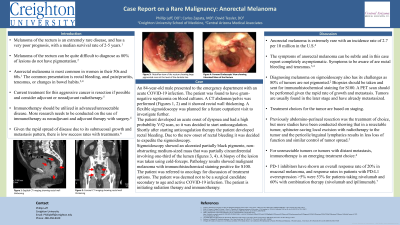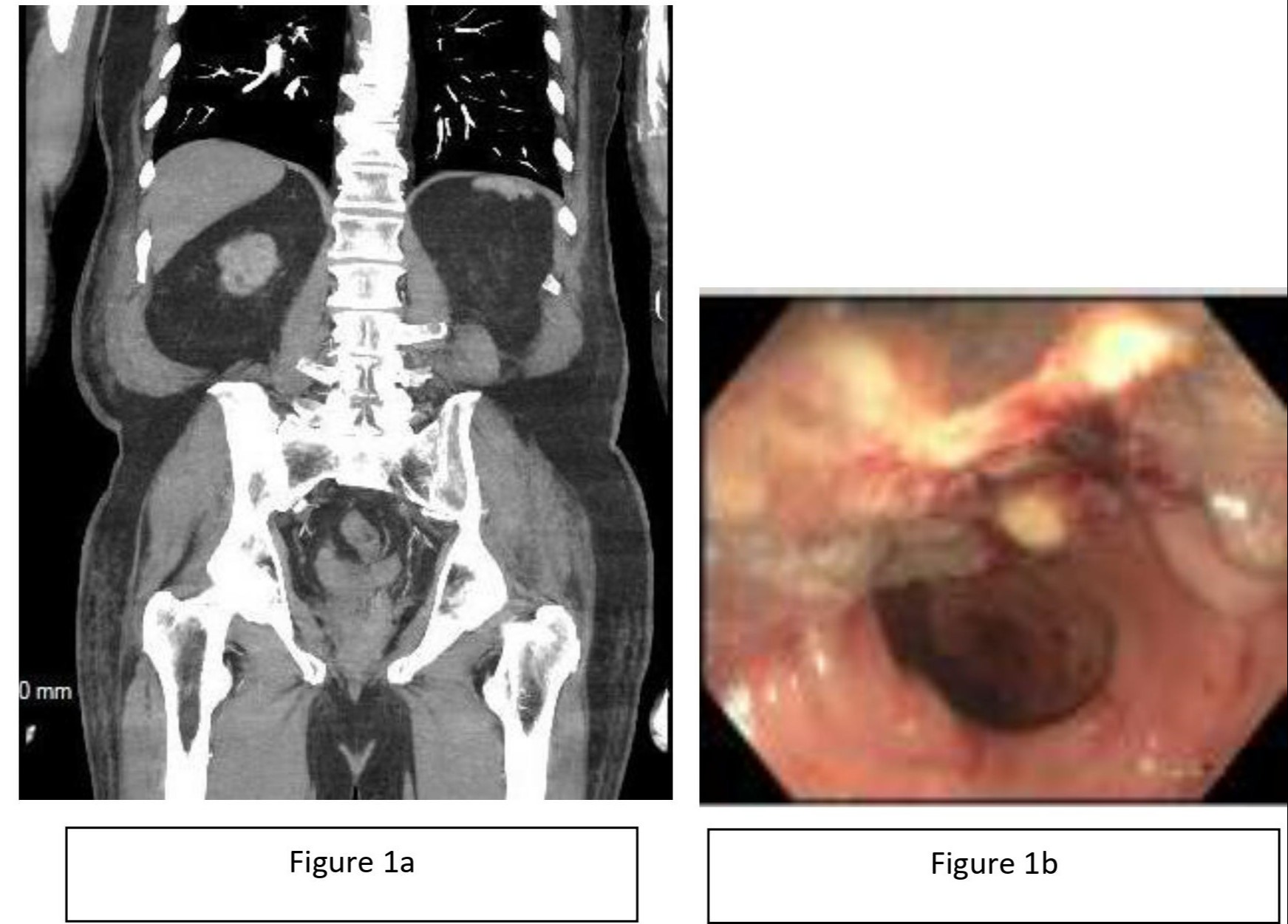Back


Poster Session D - Tuesday Morning
Category: GI Bleeding
D0312 - Case Report on a Rare Malignancy: Anorectal Melanoma
Tuesday, October 25, 2022
10:00 AM – 12:00 PM ET
Location: Crown Ballroom

Has Audio

Phillip Leff, DO
Creighton University
Scottsdale, AZ
Presenting Author(s)
Phillip Leff, DO1, Carlos Zapata, MD2, David Tessler, DO2
1Creighton University, Scottsdale, AZ; 2Central Arizona Medical Associates, Mesa, AZ
Introduction: Melanoma of the rectum is an extremely rare disease. The median survival rate is 2-5 years. Current treatment for this aggressive cancer is resection if possible and consider adjuvant or neoadjuvant radiotherapy; immunotherapy in nonresectable cases. Given the rapid spread of disease due to its submucosal growth and metastasis pattern, there is low success rates with treatments.
Case Description/Methods: An 84-year-old male presented to the emergency department with an acute COVID-19 infection. The patient was also found to have gram-negative septicemia on blood cultures, so a CT abdomen/pelvis was performed (Figure 1a). The CT showed rectal wall thickening. A flexible sigmoidoscopy was planned for a future outpatient visit after recovering from his acute infection.
The patient, however, developed an acute onset of dyspnea and had a high probability V/Q scan while in the hospital. He was started on anticoagulation, and shortly after starting therapy the patient developed bright red rectal bleeding. Due to the new onset of rectal bleeding it was decided to expedite the sigmoidoscopy.
The sigmoidoscopy was performed in the hospital showing an ulcerated partially black pigmented non-obstructing medium-sized mass that was partially circumferential involving one-third of the lumen (figure 1b). A biopsy of the lesion was taken using cold-forceps. The pathology stained positive for S100 consistent with melanoma.
The diagnosis of anorectal melanoma was made, and colorectal surgery was consulted. The patient was deemed not to be a surgical candidate secondary to age and active COVID-19 infection. Oncology was consulted, and it was decided to start the patient on radiation and immunotherapy with a PD-1 inhibitor.
Discussion: The symptoms of anorectal melanoma can be subtle and in this case report completely asymptomatic. Symptoms to be aware of are rectal bleeding and tenesmus. Diagnosing melanoma on sigmoidoscopy can be challenging as most tumors are not pigmented. Biopsies should be taken and sent for immunohistochemical staining for S100, if positive the patient should have a PET scan. Treatment choices for the tumor are based on staging. In a resectable tumor sphincter-saving local excision with radiotherapy to the site of the tumor and the pericolic and inguinal lymphatics is recommended. For unresectable tumors or tumors with distant metastasis, immunotherapy with PD-1 inhibitors (nivolumab and ipilimumab) is an emerging treatment choice.

Disclosures:
Phillip Leff, DO1, Carlos Zapata, MD2, David Tessler, DO2. D0312 - Case Report on a Rare Malignancy: Anorectal Melanoma, ACG 2022 Annual Scientific Meeting Abstracts. Charlotte, NC: American College of Gastroenterology.
1Creighton University, Scottsdale, AZ; 2Central Arizona Medical Associates, Mesa, AZ
Introduction: Melanoma of the rectum is an extremely rare disease. The median survival rate is 2-5 years. Current treatment for this aggressive cancer is resection if possible and consider adjuvant or neoadjuvant radiotherapy; immunotherapy in nonresectable cases. Given the rapid spread of disease due to its submucosal growth and metastasis pattern, there is low success rates with treatments.
Case Description/Methods: An 84-year-old male presented to the emergency department with an acute COVID-19 infection. The patient was also found to have gram-negative septicemia on blood cultures, so a CT abdomen/pelvis was performed (Figure 1a). The CT showed rectal wall thickening. A flexible sigmoidoscopy was planned for a future outpatient visit after recovering from his acute infection.
The patient, however, developed an acute onset of dyspnea and had a high probability V/Q scan while in the hospital. He was started on anticoagulation, and shortly after starting therapy the patient developed bright red rectal bleeding. Due to the new onset of rectal bleeding it was decided to expedite the sigmoidoscopy.
The sigmoidoscopy was performed in the hospital showing an ulcerated partially black pigmented non-obstructing medium-sized mass that was partially circumferential involving one-third of the lumen (figure 1b). A biopsy of the lesion was taken using cold-forceps. The pathology stained positive for S100 consistent with melanoma.
The diagnosis of anorectal melanoma was made, and colorectal surgery was consulted. The patient was deemed not to be a surgical candidate secondary to age and active COVID-19 infection. Oncology was consulted, and it was decided to start the patient on radiation and immunotherapy with a PD-1 inhibitor.
Discussion: The symptoms of anorectal melanoma can be subtle and in this case report completely asymptomatic. Symptoms to be aware of are rectal bleeding and tenesmus. Diagnosing melanoma on sigmoidoscopy can be challenging as most tumors are not pigmented. Biopsies should be taken and sent for immunohistochemical staining for S100, if positive the patient should have a PET scan. Treatment choices for the tumor are based on staging. In a resectable tumor sphincter-saving local excision with radiotherapy to the site of the tumor and the pericolic and inguinal lymphatics is recommended. For unresectable tumors or tumors with distant metastasis, immunotherapy with PD-1 inhibitors (nivolumab and ipilimumab) is an emerging treatment choice.

Figure: CT scan and sigmoidoscopy of Rectal Melanoma.
Disclosures:
Phillip Leff indicated no relevant financial relationships.
Carlos Zapata indicated no relevant financial relationships.
David Tessler: Abbvie – Speakers Bureau. Bristol-Myers-Squibb – Speakers Bureau.
Phillip Leff, DO1, Carlos Zapata, MD2, David Tessler, DO2. D0312 - Case Report on a Rare Malignancy: Anorectal Melanoma, ACG 2022 Annual Scientific Meeting Abstracts. Charlotte, NC: American College of Gastroenterology.
